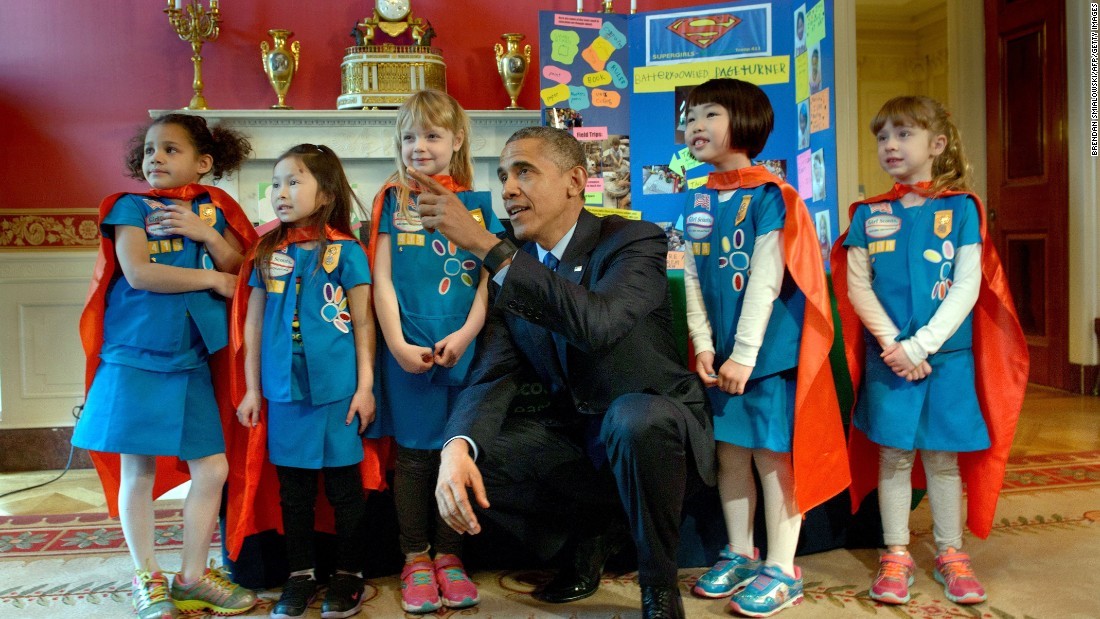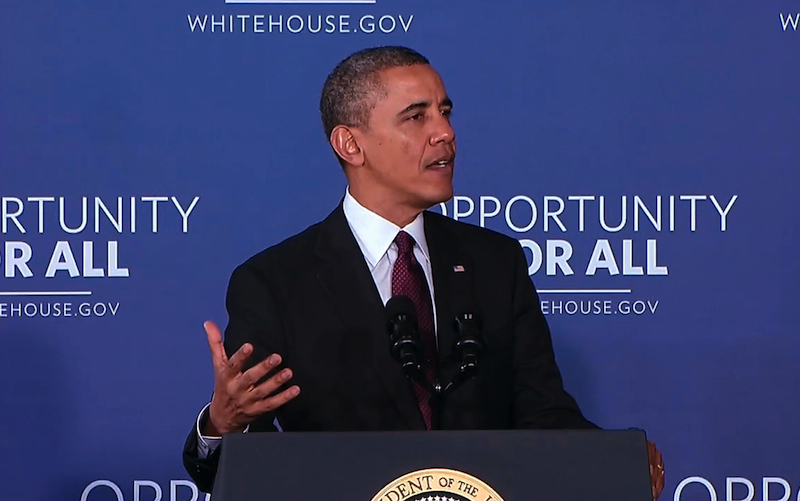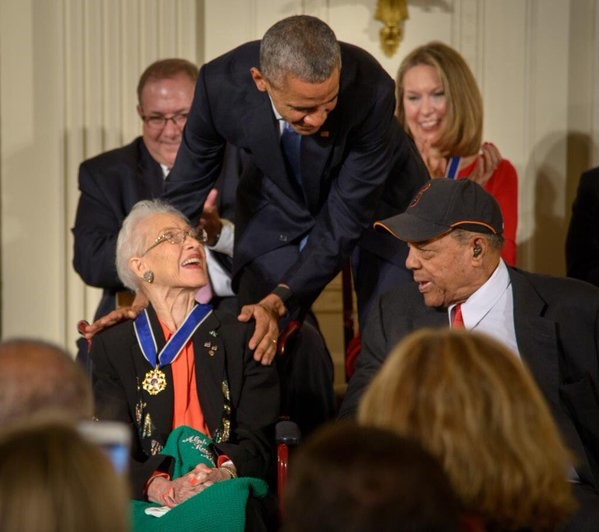
From early in his Administration, President Obama has made improving science, technology, engineering, and mathematics (STEM) education a priority—he believes that every American student deserves access to a high-quality education in STEM for both their future and for the Nation’s future. Over the past seven years, the Obama Administration’s efforts have resulted in unprecedented levels of public-private collaboration in STEM education; policies and budgets focused on maximizing Federal investment to increase student access and engagement in active, rigorous STEM-learning experiences; and meaningful efforts to inspire and recognize young inventors, discoverers, and makers.
One of the things that I’ve been focused on as President is how we create an all-hands-on-deck approach to science, technology, engineering, and math… We need to make this a priority to train an army of new teachers in these subject areas, and to make sure that all of us as a country are lifting up these subjects for the respect that they deserve.
The Administration’s actions to accelerate progress include:
- The Administration has secured more than $1 billion in private investment for improving STEM education as part of the President’s Educate to Innovate campaign.
- Thanks to deep public and private commitments, our nation is 50% of the way towards achieving the goal the President set in 2011 of preparing 100,000 new math and science teachers by 2021, and a historic 25,000 additional engineers are graduating yearly compared to when President Obama took office.
- STEM education has been incorporated into the priorities of the Department of Education (ED), as illustrated by the Administration’s signature Race to the Top competition.
- This White House has announced more than 350 commitments from college and university leadership and others to provide pathways for underrepresented students to attain STEM degrees.
- President Obama has started traditions such as the White House Science Fair to honor young people using science, technology, engineering, and mathematics to improve their communities and the world.
- And in his final budget announced this week, the President sustains this impressive track record with an investment of $3.0 billion across 14 Federal agencies for dedicated STEM education programs.
Yet there remains work to be done in 2016 and beyond. To meet the projected workforce need of 1 million additional STEM graduates by 2022, and to realize the vision of a highly diverse, creative, and sufficient STEM workforce and a STEM-literate citizenry, the Nation must engage all students. This effort must include women and minorities who are poorly represented in many STEM fields—despite the fact that these demographic groups comprise more than two-thirds of college students. Failing to engage underrepresented groups will lead to shortfalls in our Nation’s STEM workforce and, more importantly, will prevent the STEM professions from capitalizing on the power of human diversity, an historical strength and competitive edge of the American economy and will deprive some of our citizens from the engaging in rewarding and remunerative careers.
The change needed to broaden access, success, and diversity in STEM education may seem daunting. But a vast array of evidence-based teaching strategies and methods that inspire and support all students will pave the way. The last half-century of education research has helped shed light on the reasons that students—and in particular women and ethnic minorities—abandon study and careers in STEM fields. Drawing on these research-based insights, the 2017 Budget prioritizes three major areas for investment to support STEM education for all students: (1) improving STEM teaching and supporting active learning, (2) expanding access to rigorous STEM courses, and (3) addressing bias and expanding opportunities for underrepresented students in STEM.
Improving STEM Teaching and Supporting Active Learning
Abundant evidence shows that active engagement enhances learning for students of all demographics and has especially beneficial effects on women and other underrepresented groups, likely due to a greater sense of belonging that can be achieved in active classrooms. In STEM disciplines, use of active learning not only improves learning outcomes, but also helps to retain students in STEM majors. Active-learning strategies encompass a suite of practices in which students are engaged in thinking or problem solving rather than listening passively to a lecture. These strategies can be as simple as having students challenged to solve problems before a lecture that will provide them with the tools to do so, or can require more dramatic changes, such as engaging students in original research or design in introductory-level college courses.

The Administration has already supported research on and implementation of active learning in K-12 and college-level classrooms. The President’s 2017 Budget builds on past effort by investing $109 million at the National Science Foundation (NSF) in Improving Undergraduate STEM Education to ensure that students have access to the most effective learning and research opportunities—opportunities that prepare them to pursue STEM careers across disciplines. To continue support for pathways that bring excellent teachers into STEM classrooms, ED will invest $125 million in the Teacher and Principals Pathways program to support teacher-preparation programs and nonprofits partnering with school districts to create or expand high quality pathways into the teaching profession, particularly into high-need schools and high-need subjects such as STEM. In addition, later this year, the Administration will take steps to showcase the importance of active learning, and to highlight the growing force of educators, nonprofit organizations, foundations, and others who are working to expand use of active learning with students at all levels—from elementary school through college.
Expanding Access to Rigorous STEM Courses
To ensure that all students have access to relevant STEM coursework during their formative years, we as a Nation, must increase opportunities for every student to have access to a full suite of advanced STEM courses in high school. For high-school students, access to core and advanced STEM coursework is an essential part of preparing to enter the workforce equipped with relevant skills for a broad range of jobs, and to successfully pursue STEM degrees and courses in college. Exposure to STEM education correlates with success in higher education, regardless of major. Yet the most recent survey from the Department of Education’s Office for Civil Rights’ Civil Rights Data Collection shows that 50 percent of U.S. high schools do not offer calculus and 27 percent do not offer physics. Between 10 and 25 percent of high schools lack more than one of the core courses in the typical sequence of high school math and science education, such as algebra I and II, geometry, biology, or chemistry. By some estimates, just one quarter of all K-12 schools in the United States offer computer science with programming and coding. The Nation must take action to expand the diversity of schools that offer core and advanced STEM courses.

The President’s 2017 Budget includes a Computer Science for All plan that builds on the momentum at the state and local level to give every P-12 student the opportunity to learn computer science. The Budget invests $4 billion in mandatory funding at ED, available over three years, to support the ability of all 50 states to expand access for all students to hands-on computer science instruction and programs of study. In addition to state-level grants, the 2017 Budget dedicates $100 million in competitive grants specifically for leading districts to execute ambitious computer science-expansion efforts for all students—with a focus on reaching traditionally underrepresented students—and to serve as models for national replication. More information on this initiative can be found in the Computer Science for All fact sheet.

The 2017 Budget also includes additional investments to help narrow STEM course gaps, including a new $80 million competitive program at ED to provide resources for communities to launch Next-Generation High Schools that will be laboratories for cutting-edge STEM teaching and learning, and $500 million for Student Support and Academic Enrichment Grants, a new block grant (also at ED and authorized by the Every Student Succeeds Act (ESSA)) that would provide flexible-formula grant funds to assist school districts in delivering a well-rounded education to their students through a range of locally determined activities, including support for STEM education.
Addressing Bias and Expanding Opportunities for Underrepresented Students in STEM
One of the greatest strengths of the American talent pool and workforce is diversity. But unnecessary barriers and the impact of bias too often limit who pursues, persists, and succeeds in STEM. To engage the diversity of Americans more fully, access the full potential of the STEM talent pool, and provide equitable opportunities, we as a Nation must respond to the growing research on the impact of implicit barriers and unconscious bias driving interested students away from STEM.

In the President’s 2017 Budget, NSF, as part of its Inclusion across the Nation of Communities of Learners of Underrepresented Discoverers in Engineering and Science (NSF INCLUDES) program, through a comprehensive R&D effort, will invest $16 million in alliances to develop new ways to increase diversity in STEM. In addition, ED will invest in a set of programs that have a strong focus on increasing access to STEM education, including $108 million in the Hispanic-Serving Institutions (HSI) STEM and Articulation program, sustained funding for Gaining Early Awareness and Readiness for Undergraduate Programs (GEAR UP), and increased funding for ED’s Federal TRIO programs.
This Administration has already taken many steps to reduce barriers and expand STEM opportunities for all students, including starting the tradition of the White House Science Fair, and launching the Educate to Innovate initiative. To build upon past efforts, the Administration is working with the media and entertainment industry to change the image of STEM jobs and the people who do them. This work will provide role models to inspire diverse young people to pursue STEM careers and offer the public a more realistic and positive image of STEM fields than is evident in current programming. In addition, the Administration is convening Federal STEM agencies to delineate policies that would enhance training of Federal employees in mitigating the effects of bias on workplace behaviors.
Progress on the STEM for All goals will increase the number and diversity of students who achieve in STEM education and comprise the future STEM workforce. To turn STEM innovation to address the complex challenges confronting the world today and in the future, the Nation must engage all of the available brainpower, creativity, and talent in the STEM enterprise. We cannot afford to squander the opportunity.
Learn more about the Administration’s STEM for All efforts here, and get involved by making a commitment in in support of STEM for All here.
Jo Handelsman is Associate Director for Science at the White House Office of Science and Technology Policy.
Megan Smith is the U.S. Chief Technology Officer.

